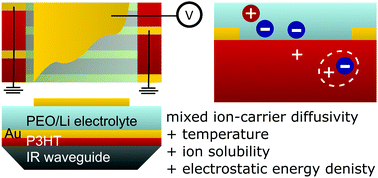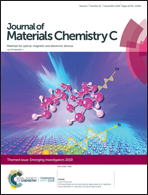Vogel–Tammann–Fulcher model for charging dynamics in an organic electrochemical transistor†
Abstract
The mechanisms which underlie the dynamic behavior of organic electrochemical transistors are investigated with a series of in situ infrared spectroscopic measurements on metal–electrolyte–semiconductor capacitors. By varying the device geometry, we are able to separate the fundamental processes that determine transistor charging dynamics, namely, charge carrier mobility, ion conduction in the electrolyte, and mixed ion-carrier diffusion in the semiconductor. Surprisingly, charge carrier mobility has very little effect on the dynamics. Instead, either dielectric polarization or ion-carrier diffusion is the rate limiting step, depending on device geometry. The voltage dependence of the ion diffusion constant is determined, showing an exponential increase with the square of the applied voltage. Dynamics of several different ionic species are also measured. Paradoxically, faster transport is shown for larger anions. Temperature dependent measurements are also performed; ion diffusion shows an exponential slowing at lower temperature. The ion-carrier diffusivity can be understood with the Vogel–Tamman–Fulcher (VTF) equation whereby the activation energy is dependent on electrostatic energy density and the ionic solubility in the semiconductor. This model presents a generalizable framework to approach structure–property relationships for ion transport in organic semiconducting materials.

- This article is part of the themed collection: Journal of Materials Chemistry C Emerging Investigators


 Please wait while we load your content...
Please wait while we load your content...